
EN: (A) Dorsal attachment point, (A/2) Sternal attachment elements, (B)
Shoulder straps, (C) Thigh loops, (D) Adjustment buckles, (E) Sternal sling
and buckle, (F) Load indicators.
Material of textile parts: polyester.
Material of metallic part: zinc plated carbon steel.
IT: (A) Punto di attacco dorsale, (A/2) Elementi di attacco sternale, (B)
Spallacci, (C) Fibbie per gli anelli della coscia, (D) Fibbie di regolazione, (E)
Imbracatura e bbia sternale, (F) Indicatori di carico.
Materiale delle parti tessili: poliestere.
Materiale della parte metallica: acciaio al carbonio zincato.
FR: (A) Point d’attache dorsal, (A/2) éléments d’attache sternaux, (B) sangles
d’épaule, (C) boucles de cuisses, (D) boucles d’ajustement, (E) anneau de
sangle et boucle sternales, (F) Indicateurs de charge.
Matériau des pièces textiles : polyester.
Matériau de la partie métallique : acier au carbone zingué.
DE: (A) Dorsaler (hinterer) Befestigungspunkt, (A/2) Sternum (vorn)-
Befestigungselemente, (B) Schultergurte, (C) Oberschenkelschlaufen-
Schnallen, (D) verstellbare Schnallen, (E) Sternum-Schlinge und -Schnalle,
(F) Belastungsanzeigen.
Material der textilen Komponenten: Polyester.
Material der Metalles: verzinkter Kohlenstoffstahl.
EN: Category III Personal Protective Equipment 8W0.320 “SIERRA
DUO ANSI” (g. 1) is:
- a full body harness for connection to fall arrest systems, tted with
a dorsal attachment point identied with (A) and with a sternal
attachment point consisting of two attachment elements identied
with (A/2);
- part of a system protecting against impact caused by fall from a
height;
- certied according to standards EN 361:2002.
M/L
8W0323*****
XL
8W0325*****
A (cm) 72-105 89-130
B (cm) 50-62 62-80
(g) 850 900
SIZE
A
***** = colours indices TAILLE • GRÖSSE
IT: Categoria III Il dispositivo di protezione individuale 8W0.320 “SIER-
RA DUO ANSI” (g. 1) è:
- un’imbracatura a corpo intero per il collegamento ai sistemi anticaduta,
dotata di un punto di attacco dorsale identicato con (A) e di un punto
di attacco sternale costituito da due elementi di attacco identicati
con (A/2);
- parte di un sistema di protezione contro gli urti causati dalle cadute
dall’alto;
- certicato secondo le norme EN 361:2002.
FR: L’équipement de protection individuelle de catégorie III 8W0.320
«SIERRA DUO ANSI» (g. 1) :
- est un harnais complet pour connexion aux systèmes d’arrêt
des chutes, équipé d’un point d’attache dorsal identié par (A) et
d’un point d’attache sternal constitué de deux éléments d’attache
identiés par (A/2) ;
- fait partie d’un système de protection contre les chocs causés par une
chute de hauteur ;
- certiés selon les normes EN 361:2002.
DE: Kategorie III Persönliche Schutzausrüstung 8W0.320 „SIERRA
DUO ANSI“ (Abb. 1) ist:
- ein Ganzkörper-Geschirr zur Verbindung mit Absturzschutzsystemen,
das mit einem mit gekennzeichneten Befestigungspunkt am
Dorsaler (A) und mit einem Befestigungspunkt am Sternum, der aus
zwei mit (A/2) gekennzeichneten Befestigungselementen besteht,
ausgestattet ist;
– ein Teil eines Systems zum Schutz von Stürzen aus großer Höhe;
– eine gemäß EN 361:2002 Typ A zertizierte persönliche
Schutzausrüstung
NOMENCLATURE • TERMINOLOGIE
NOMENCLATURE • NOMENCLATURA
DESCRIPTION • DESCRIZIONE
DESCRIPTION • BESCHREIBUNG
2
D
E
A/2
F
C
B
A
1
4
3
STERNUM
A/2 A
10cm
5cm
5cm
DORSAL
ARMPIT
ED
ZZV05633 Rev.1
SIERRA DUO ANSI
KONG s.p.a.
Via XXV Aprile, 4 - (zona industriale)
I - 23804 MONTE MARENZO (LC) - ITALY
Tel +39 0341630506 - Fax +39 0341641550 - [email protected]
8W0.320
Stáhněte si překlad ve vašem jazyce - Laden Sie die Übersetzung in
Ihrer Sprache herunter - Download the translation in your language
- Bájate la traducción en tu idioma - Télécharger la traduction dans
vostre langue - Scarica la traduzione nella tua lingua - Download
de vertaling in je eigen taal - Pobierz tłumaczenie w twoim języku
- Faça o download da tradução no seu idioma - Скачайте перевод
на ваш язык - 下载您的语言的译文
EU USE

8 – SPECIFIC INFORMATION
Fig. 3 – Dressing – First of all check the size, choosing the correct one for
you (see SIZE table). To t the harness correctly:
- loosen the buckles (D),
- unthread the sling (E) from its buckle;
- holding the harness by the dorsal attachment point (A) spread out the
shoulder straps (B);
- slip your legs through thigh loops (C);
- slip your arms into the shoulder straps (B);
- thread the sternal sling (E) through its buckle;
- adjust the harness tightening the buckles (D) and check the attachment
elements (dorsal and sternal) position;
- position the exceeding slings in the elastic loops.
Fig. 4 –Attachment points – The dorsal attachment point (A) and the
attachment elements (A/2) are suitable to be used in fall arrest systems.
Compatibility – This device has been designed to be used with:
- belts according to EN358;
- connectors according to EN362;
- energy absorbers according to EN355;
- rope adjustment devices according to EN12841 type A;
- guided fall arresters according to EN353-1 o EN353-2.
Important:
- if load indicators (F) are unstitched replace the device;
- The PPEs composing the fall prevention/protection system must properly be
selected according to the weight of the user and the condition of applica-
tion, paying specially attention to energy absorbing elements;
- this device is only a part of a system preventing/protecting against impact
caused by fall from a height and therefore it shall be connected to other de-
vices (i.e. shock absorber, ropes, etc.) in order to obtain a fall arrest system
suitable to the situation and conform to current regulations;
- during use regularly check:
- the fastening of the buckles (D);
- if the device is undamaged.
Warning:
- do not connect one only attachment element, they shall be used as
a pair: the sternal attachment (A/2) consists of two attachment ele-
ments;
- prolonged suspension on the harness, especially in motionless con-
ditions, may cause harness hang syndrome (or suspension trauma)
that can lead to loss of consciousness and even death.
9 – PRE AND POST USE CHECKS
Before and after use, make sure that the device is in an efcient condition and
that it is working properly, in particular, check that:
- it is suitable for the intended use;
- load indicators (F) are intact;
- has not been mechanically deformed;
- does not show cracks, wear, corrosion and oxidation;
- stitching are intact, and there are no cut or loose threads;
- buckles (D) function correctly (locking, adjusting and locking);
- textile parts do not have cuts, burns, chemical residues, excessive hair,
wear, in particular check the areas in contact with metal components
(buckles, attachment point, etc..);
- markings are legible.
Before use and in a position that is completely safe, on each occasion check
that the device holds correctly by putting your weight on it.
8 – INFORMAZIONI SPECIFICHE
Fig. 3 - Vestizione - Prima di tutto controllare la taglia, scegliendo quella
giusta per se stessi (vedere tabella DIMENSIONI). Per montare correttamente
l’imbracatura:
- allentare le bbie (D);
- slare l’imbracatura (E) dalla sua bbia;
- tenendo l’imbracatura per il punto di attacco dorsale (A) stendere gli spallacci
(B);
- far scivolare le gambe attraverso i cosciali (C);
- inlare le braccia nelle bretelle (B);
- inlare l’imbracatura sternale (E) attraverso la sua bbia;
- regolare l’imbracatura stringendo le bbie (D) e controllare la posizione degli
elementi di ssaggio (dorsale e sternale);
- posizionare le imbracature in eccesso nei loop elastici.
Fig. 4 - Punti di attacco - Il punto di attacco dorsale (A) e gli elementi di
attacco (A/2) sono adatti ad essere utilizzati nei sistemi di arresto caduta.
Compatibilità - Questo dispositivo è stato progettato per essere utilizzato
con:
- cinghie secondo norma EN358;
- connettori secondo norma EN362;
- assorbitori di energia secondo norma EN355;
- dispositivi di regolazione della fune secondo norma EN12841 tipo A;
- dispositivi anticaduta guidati secondo norma EN353-1 o EN353-2.
Importante:
- se gli indicatori di carico (F) sono senza cuciture, sostituire l’apparecchio;
- I DPI che compongono il sistema di prevenzione/protezione anticaduta
devono essere opportunamente selezionati in funzione del peso dell’utente e
delle condizioni di applicazione, prestando particolare attenzione agli elementi
che assorbono energia;
- questo dispositivo è solo una parte di un sistema che previene/protegge
dagli urti causati da una caduta dall’alto e quindi deve essere collegato ad
altri dispositivi (ossia ammortizzatore, funi, ecc.) per ottenere un sistema
anticaduta adatto alla situazione e conforme alle normative vigenti;
- durante l’uso controllare regolarmente:
- il ssaggio delle bbie (C e D);
- se il dispositivo non è danneggiato.
Avvertenze:
- non collegare un solo elemento di ssaggio, essi devono essere uti-
lizzati in coppia: l’attacco sternale (A/2) è costituito da due elementi di
ssaggio;
- la sospensione prolungata sull’imbracatura, soprattutto in condizioni
di immobilità, può causare la sindrome da sospensione dell’imbracatura
(o trauma da sospensione) che può portare alla perdita di coscienza e
persino alla morte.
9 - VERIFICHE PRE E POST UTILIZZO
Prima e dopo l’uso, assicurarsi che il dispositivo sia in condizioni di efcienza
e che funzioni correttamente, in particolare, vericare che:
- è adatto all’uso previsto;
- gli indicatori di carico (F) sono intatti;
- non è stato deformato meccanicamente;
- non mostra crepe, usura, corrosione e ossidazione;
- le cuciture sono intatte e non ci sono li tagliati o allentati;
- le bbie (C e D) funzionano correttamente (bloccaggio, regolazione e
bloccaggio);
- le parti tessili non presentano tagli, bruciature, residui chimici, peluria in
eccesso, usura, in particolare controllare le zone a contatto con i componenti
metallici (bbie, punto di attacco, ecc.);
- i segni sono leggibili.
Prima dell’uso e in una posizione completamente sicura, vericare ogni volta
che l’apparecchio regga correttamente appoggiandovi sopra il proprio peso.
8 – INFORMATIONS SPÉCIFIQUES
Fig. 3 – Habillage – Avant de mettre le harnais, vérier que la taille soit
adéquate (voir le tableau des tailles « SIZE ») Pour que le harnais soit bien
ajusté :
- desserrer les boucles (D) ;
- détacher l’anneau de sangle sternal (E) de la boucle correspondante ;
- en tenant le harnais par le point d’attache dorsal (A), écarter les sangles
d’épaule (B) ;
- glissez vos jambes dans les boucles des cuisses (C) ;
- glisser vos bras dans les bretelles (B) ;
- enler l’anneau de sangle sternal (E) dans la boucle correspondante ;
- ajuster le harnais en tirant sur les boucles (D) et vérier la position des
éléments d’attache (dorsale et sternale) ;
- positionner les anneaux de sangle excédentaires dans les boucles
élastiques.
Fig. 4 – Points d’attache – Le point d’attache dorsal (A) et les éléments de
xation (A/2) peuvent être utilisés dans les systèmes d’arrêt des chutes.
Compatibilité – Ce dispositif a été conçu pour être utilisé avec :
- des ceintures conformément à la norme EN358 ;
- des connecteurs conformément à la norme EN362 ;
- des absorbeurs d’énergie selon la norme EN355 ;
- des dispositifs de réglage des cordes selon la norme EN12841 type A ;
- des antichutes guidés selon la norme EN353-1 ou EN353-2.
Important :
- si les indicateurs de charge (F) sont décousus, remplacer le dispositif ;
- Les EPI composant le système de prévention/protection contre les chutes
doivent être choisis correctement en fonction du poids de l’utilisateur et des
conditions d’application, en accordant une attention particulière aux éléments
d’absorption d’énergie ;
- ce dispositif ne constitue qu’une partie d’un système de prévention/
protection contre les chocs provoqués par une chute de hauteur et doit donc
être connecté à d’autres dispositifs (c’est-à-dire amortisseur, cordes, etc.) an
d’obtenir un système d’arrêt des chutes adapté à la situation et conforme aux
réglementations en vigueur ;
- lors de l’emploi, vérier régulièrement :
- la xation des boucles (C et D) ;
- si le dispositif n’est pas endommagé.
Attention :
- ne jamais se lier à un seul élément d’attache, ils doivent être utilisés en
paire : l’attache sternale (A/2) se compose de deux éléments d’attache ;
- une suspension prolongée au harnais, en particulier dans des condi-
tions d’immobilité, peut provoquer le syndrome du harnais (ou syn-
drome de suspension) qui peut causer une perte de conscience et
même la mort.
9 - VÉRIFICATIONS AVANT ET APRÈS L’UTILISATION
Avant et après utilisation, s’assurer que le dispositif est en bon état et
fonctionne correctement, vérier notamment que :
- il convient à l’utilisation prévue ;
- les indicateurs de charge (F) sont intacts ;
- il n’a pas été tordu mécaniquement ;
- il ne présente pas de ssures, d’usure, de corrosion et d’oxydation ;
- les coutures sont intactes, et qu’il n’y a pas de ls coupés ou détachés ;
- les boucles (C et D) fonctionnent correctement (verrouillage, réglage et
blocage) ;
- les parties textiles ne présentent pas de coupures, de brûlures, de résidus
chimiques, d’excès de l, d’usure, vérier notamment les parties en contact
avec les composants métalliques (boucles, point d’attache, etc.) ;
- les marques sont lisibles.
Avant l’emploi et dans une position de sécurité absolue, s’assurer que le
dispositif tienne correctement en effectuant des essais de suspension.
8 – SPEZIFISCHE ANGABEN
Abb. 3 - Ausrüsten - Überprüfen Sie zunächst die Größe und wählen Sie
die, für Sie, richtige Größe aus (siehe Größentabelle). Um das Geschirr
richtig zu befestigen:
- lösen Sie die Schnallen (D);
- ziehen Sie die Schlinge (E) aus ihrer Schnalle heraus;
- halten Sie den Gurt an dem dorsalen (hinteren) Befestigungspunkt (A) und
spreizen der Schultergurte (B);
- die Beine sind durch die Oberschenkelschlaufen (C) zu führen;
- schlüpfen Sie Ihre Arme in die Schultergurte (B);
- fädeln Sie die Brustschlinge (E) durch die entsprechende Schnalle;
- justieren Sie das Geschirr durch die Regulierung der Schnallen (D) und
überprüfen die Position der Befestigungselemente (vorne und hinten);
- platzieren Sie die überstehenden Schlingen in den elastischen Schlaufen.
Abb. 4 - Befestigungspunkte - Der hintere (dorsale) Befestigungspunkt
(A) und die Befestigungspunkte (A/2) eignen sich zur Verwendung in
Absturzschutzsystemen.
Kompatibilität - Dieses Gerät wurde für die Verwendung mit den folgenden
Einrichtungen konzipiert:
- Gurten nach EN 358;
- Verbindungsstücken nach EN 362;
- Energieaufnahmeeinrichtung gemäß EN 355;
- Seileinstellvorrichtungen nach EN 12841 Typ A;
- Steigschutzeinrichtung nach EN 353-1 oder EN 353-2.
Wichtig:
- wenn der Lastenanzeiger (F) sich löst, ersetzen Sie das Geschirr;
- die persönlichen Schutzeinrichtungen, aus denen sich das
Absturzsicherungssystem zusammensetzt, müssen entsprechend dem
Gewicht des Benutzers und der Bedingungen der Nutzung richtig ausgewählt
werden, wobei besonders auf die energieabsorbierenden Elemente geachtet
werden muss;
- diese Vorrichtung ist nur ein Teil eines Systems, das einen Aufprall durch
einen Sturz aus der Höhe verhindert bzw. davor schützt, und muss daher
mit anderen Vorrichtungen (d. h. Stoßdämpfern, Seilen usw.) verbunden
werden, um ein, der Situation angepasstes und den geltenden Vorschriften
entsprechendes, Absturzschutzsystem zu erhalten;
- während der Benutzung muss regelmäßig überprüft werden:
- die Verschlüsse der Schnallen (C und D);
- ob das Geschirr unbeschädigt ist.
Warnung:
- verbinden nicht nur ein einziges Befestigungselement, sie sind als
Paar zu verwenden: Die Befestigung am Brustbein (A/2) besteht aus
zwei Befestigungselementen;
- längeres Hängen an einem Geschirr, insbesondere bei Bewegungs-
losigkeit, kann das Hängegurt-Syndrom (oder ein Hängetrauma) ver-
ursachen. Dieses kann zum Verlust des Bewusstseins und sogar zum
Tod führen.
9 - KONTROLLEN VOR UND NACH DER VERWENDUNG
Vergewissern Sie vor und nach der Verwendung, dass sich das Produkt in
einem funktionstüchtigen Zustand bendet und ordnungsgemäß arbeitet.
Prüfen Sie insbesondere, dass:
- es für den vorgesehenen Verwendungszweck geeignet ist;
- die Belastungsindikatoren (F) intakt sind;
- keine mechanischen Verformungen vorhanden sind;
- keine Risse, kein Verschleiß, keine Korrosion und keine Oxidation
vorhanden sind;
- die Nähte intakt sind und keine abgeschnittenen oder losen Fäden
vorhanden sind;
- die Schnallen (C und D) korrekt arbeiten (Verriegelung, Einstellung und
Verriegelung);
- die textilen Teile keine Schnitte, Verbrennungen, chemische Rückstände,
übermäßige Haare, Abnutzung aufweisen, insbesonders in den Bereichen,
die mit den Metallkomponenten in Berührung kommen (Schnallen,
Befestigungspunkte usw.);
- Markierungen gut lesbar sind.
Prüfen Sie vor jeder Benutzung und in einer vollkommen gesicherten
Position, ob das Gerät richtig hält, indem Sie es mit Ihrem Gewicht belasten.
EN
Master text: ITALIAN Teste de référence: ITALIENNE Referenztext: ITALIENISCH
IT FR DE
NB n° 0123 TÜV SÜD
Product Service GmbH
Daimlerstraße 11
85748 Garching - Germany
Download the declarance of conformity at:
Scarica la dichiarazione di conformità a :
Télécharger la déclaration de conformité à:
Laden Sie die Konformitätserlärung herunter zu:
www kong it/conformity
Conformity to the European Standard EN 361:2002, Full body harnesses for fall arrest systems
Conformità alla norma europea EN 361:2002, Imbracature a corpo intero per sistemi anticaduta
Conforme à la norme européenne EN 361:2002, Équipement de protection individuelle contre les
chutes de hauteur - Harnais d’antichute
Konformität mit der Europäischen Norm EN 361:2002, Ganzkörper-Geschirr für Auffangsysteme
EN 361:2002 A A/2
Attachment point for fall arrest systems
Punto di attacco per sistemi anticaduta
Point d’attache pour les systèmes d’arrêt des chutes
Befestigungspunkte für Absturzsicherungssysteme
Attachment element for fall arrest systems
Elemento di ssaggio per sistemi anticaduta
Élément de xation pour les systèmes
d’arrêt des chutes
Befestigungselemente für Absturzsicherungssysteme
Adjusting and locking of the buckles
Regolazione e bloccaggio delle bbie
Ajustement et verrouillage des boucles
Verstell- und verschließbare Schnallen
Dorsal attachment point
Punto di attacco dorsale
Point d’attache dorsal
Dorsaler (hinterer)
Befestigungspunkt
Sternal attachment point
Punto di attacco sternale
Point d’attache du sternum
Sternaler (vorderer)
Befestigungspunkt
CERTIFIED BY • CERTIFICATO DA
CERTIFIÉ PAR • ZERTIFIZIERT VON
MARKING • MARCATURA
MARKIERUNG • MARQUAGE

EN................................................................................
ANSI/ASSE Z359 - Requirements for Proper Use and
Maintenance of Full Body Harnesses
These are general requirements and information provided by ANSI/
ASSE Z359, the Manufacturer of this equipment may impose more
stringent restrictions on the use of the products they manufacturer,
see the Manufacturer’s instructions.
1 - GENERAL INFORMATION
1.1 - The user’s organization shall retain the manufacturer’s
instructions and make them readily available to all users.
Users shall read and perfectly understand the information provided
by the manufacturer before using the device, shall comply with all
instructions regarding the inspection, maintenance and storage of
the equipment and make sure that the device is in perfect condition
and working properly. Important: this information relates to the
characteristics, services, assembly, disassembly, maintenance,
conservation, disinfection, etc. of the device. Although it does
include some suggestions on how to use the device, it cannot be
considered a true to life instruction manual (the same as an operating
and maintenance handbook for a car does not teach how to drive
it and does not replace a driving school). Warning: rescue work,
tree climbing and works at height are activities with a high
degree of risk, which may lead to accidents and even death.
The user takes complete responsibility for the risks deriving from
these activities and from using our devices. This device can be used
only by individuals medically t. It is essential that the users of this
type of equipment receive proper training and instruction, including
detailed procedures for the safe use of such equipment in their
work application. ANSI/ASSE Z359.2 establishes guidelines and
requirements for an employer’s managed fall protection program,
including policy statements, duties and responsibilities, training and
evaluations, minimum requirements for fall protection procedures,
eliminating and controlling fall hazards, rescue procedures, incident
investigations, and evaluating program effectiveness.
1.2 - If the user has the slightest doubt concerning the efciency of
the device, it shall be replaced immediately, particularly after having
used it to arrest a fall.
1.3 - Minimum resistance of anchoring points, on both natural and
articial elements, can be at least 12 kN. The assessment of those
made on natural elements (rocks, plants, etc.) is possible only
empirically, and can therefore be performed by a competent expert,
while those on articial elements (metal, concrete, etc.) can be
calculated scientically, and can therefore be performed by qualied
personnel.
1.4 – 8W0.050 SIERRA DUO ANSI is tested in accordance ANSI/
ASSE Z359.11-2014 by testing laboratory no. 1539 DOLOMITICERT
scarl - zona industriale Villanova - 32013 Longarone BL - Italia,
meeting standard ISO 17025.
This device is inspected in accordance with the procedures of the
Quality System certied according to the UNI EN ISO 9001.
Warning: laboratory tests, inspections, information and norms
do not always manage to reproduce what actually happens in
practice, and so performance under real usage conditions in a
natural environment may differ, sometimes even considerably.
The best information can be gained by continual practice under
the supervision of skilled, expert, qualied individuals.
2 - WARNINGS
- It is strictly forbidden to altering and/or repair the device, only
the equipment manufacturer, or persons or entities authorized
by the manufacturer, are allowed to repair the equipment.
- Before use make sure that the device is suitable for the purpose:
only the techniques that are not crossed out are permitted, any
other use is considered improper and therefore potentially
dangerous.
- Verify combinations of components or sub-systems, or both,
they have not to affect or interfere with the safe function of each
other.
- Improper use, deformation, falls, wear, contact with chemical
substances, chemical contamination, exposure to direct
sunlight (UV degradation), heat sources and ames, exposure
to temperatures below -20°F or higher than +120°F, are some
examples of other causes that may produce a harmful effect, or
reduce, limit or end the life of the device. We strongly suggest using
the device personally in order to continuously monitor the degree of
protection and efciency.
- At low temperatures, the presence of moisture can form ice that,
on textile devices, can reduce exibility and increases the risk of
cutting and abrasion.
- Pay particular attention when using the equipment around moving
machinery and electrical hazards, sharp edges or abrasive surfaces.
3 – MAINTENANCE AND STORAGE
- Equipment which is in need of, or scheduled for maintenance shall
be tagged as “unusable” and removed from service.
- Maintenance and storage of equipment shall be conducted by the
user’s organization, consists of washing in warm drinking water
(90°F), possibly with the addition of neutral detergent. Rinse and,
without spinning, leave it to dry without leaving it in the direct
sunlight.
- In addition, if necessary disinfect the device, soaking it in warm
water containing 1% of sodium hypochlorite (bleach). Rinse with
drinking water and, without spinning, leave it to dry without leaving it
in the direct sunlight. Avoid sterilising textile devices in an autoclave.
- Equipment shall be stored in a manner as to preclude damage from
environment: maintain temperature between 5-30°C (40-85 °F) and
relative humidity between 40-90%, avoid exposure to light, UV,
sharp edges, excessive moisture, oil, chemicals and their vapours
or other degrading elements.
- Exceptional maintenance and storage issues, which may arise
due to unusual conditions of use, shall be addressed with the
manufacturer.
4 – INSPECTION
Inspection criteria for the equipment shall be set by the user’s
organization. Such criteria for the equipment shall equal or exceed the
criteria established by ANSI/ASSE Z359.2:13 or the manufacturer’s
instructions, whichever is greater. The outcome of these periodic
inspections shall be recorded on the device’s inspection chart or a
designated register.
When inspection reveals defects in, damage to, or inadequate
maintenance of equipment, the equipment shall be permanently
removed from service or undergo adequate corrective maintenance, by
the original equipment manufacturer or their designate, before return to
service.
In addition to the inspection requirements set forth in the manufacturer’s
instructions, the equipment shall be inspected by the user before and
after using the device and additionally by a competent person, other
than the user, at interval of no more than one year for:
- absence or illegibility of markings,
- absence of any elements affecting the equipment form, t or
function,
- evidence of broken stitches xed to load indicators,
- evidence of defects in or damage to hardware elements including
cracks, sharp edges, deformation, corrosion, chemical attack,
excessive heating, alteration and excessive wear,
- evidence of defects in or damage to strap or ropes including fraying,
unsplicing, unlaying, kinking, knotting, roping, broken or pulled
stitches, excessive elongation, chemical attack, excessive soiling,
abrasion, alteration, excessive aging and excessive wear.
5 - DEVICE LIFE
The lifespan of this device is 10 years from the date of production
(indicated in the serial number) as long as: maintenance and storage
are carried out as described in point 5, the results of pre-use, post-use
and periodic inspections are all positive, and the device is used correctly.
6 – LEGAL OBLIGATIONS
Professional and recreational activities are often regulated by specic
national or governmental laws that may impose specic limits and/or
requirements for the personal fall arrest systems, which includes the
Full Body Harness in their components. The user is obliged to know and
apply these laws, which may in some cases impose obligations different
from those contained in this information.
7 – GUARANTEE
The manufacturer guarantees that the device complies with regulations
in force at the time of production. The guarantee covering faults is
limited to production defects and raw materials. It does not include wear
and tear, oxidation, damages caused by improper use and/or during
competition, incorrect maintenance, transport, conservation, storage,
etc. The guarantee becomes void as soon as the device is modied
or tampered with. The validity corresponds to the legal guarantee of
the country where the device was sold by the manufacturer, with effect
from the date of sale. After this period no claim can be made against the
manufacturer. Any request for repair or replacement under this warranty
shall be accompanied by a proof of purchase. If the defect is accepted,
the manufacturer, at its sole discretion, will repair, replace or refund the
device. Under no circumstances does the manufacturer’s liability extend
beyond the invoice price of the device.
8 - USE INFORMATION
8W0.050 SIERRA DUO ANSI (g. 1) is a full body harnesses (FBH)
meet ANSI/ASSE Z359.11:2014, tted with two attachment points, one
dorsal (C) and one sternal (D) consisting of two attachment elements.
It is intended to be used with other components of a personal fall arrest
system that limit maximum arrest forces to 1800 pounds (8 kN) or less.
Fig. 1 – Nomenclature and main materials: (A) Shoulder straps of
polyester, (B) Sit harnesses of polyester, (C) Dorsal attachment point of
carbon steel, (D) Sternal attachment point of polyester, (E) Adjustment
buckles of carbon steel, (F) Sternal sling of polyester, (G) Loops of nylon
or polyester, (H) Slings of polyester, (I) Load indicators.
Warning: a prolonged suspension onto a harness, above all if
unconscious, may cause the suspension syndrome, also called
suspension trauma or orthostatic intolerance, that can lead to fatal
consequences!
It is a serious condition that can be controlled by post fall suspension
relief devices and prompt rescue. A conscious user may remove tension
from around the legs, freeing blood ow, which can delay the onset of
suspension intolerance.
8.1 - Wearability
First of all check the size-choosing the correct one for you (see SIZE
table), paying particular attention to ensure that buckles are connected
and aligned correctly, leg straps and shoulder straps are kept snug at all
times, chest straps are located in the middle chest area (g.5), and leg
straps are positioned and snug to avoid contact with the genitalia should
a fall occur.
To wear the harness correctly:
a) loosen the slings (H),
b) unthread the sternal sling (F) from its buckle,
c) holding the harness by the dorsal attachment point (C) spread out the
shoulder straps (A) – (g.2),
d) slip your legs through the belt (B),
e) slip your arms into the shoulder straps (A),
f) thread the sternal sling (F) through its buckle (g. 3),
g) adjust the harness tightening the slings (H) - (g. 4) and check
attachment elements (dorsal and sternal) correct positioning,
h) position the loops (G) to hold the exceeding sling, which can get
caught or cause accidental disengagement of an adjuster.
Important:
- before using the harness, nd a completely safe position and carry
out movements and suspension tests on each attachment point to
make sure the harness is of the right size, adjusted properly and
comfortable for your intended use,
- regularly check the closure of the adjustment buckles when in use,
- when not in use, unused lanyard legs that are still attached to a Full
Body Harness D-ring should not be attached to a work positioning
element or any other structural element on the Full Body Harness.
8.2 – Use in a fall arrest system
For the sake of safety in case of risk of falls from a height, it is essential
to:
- assess the risks and make sure that the whole system, where this
device is only a component, is reliable and safe,
- prepare a rescue plan to deal with any emergencies possibly
arising while the device is being used,
- have the means at hands to implement the rescue plan,
- make sure that the anchoring device or the anchoring point is
always positioned as high up as possible, and that work is done
in such way as to reduce potential falls and relevant heights to
a minimum,
- a harness is only a component of a fall arrest system, therefore
it shall be connected to other devices (i.e. shock absorber,
ropes, etc.) in order to obtain a fall arrest system,
- an energy absorber can be used to limit maximum arrest forces
to 1800 pounds (8 kN),
- in order to avoid all possible problems (e.g. ground, material
rubbing against the rock face, abrasions, etc..), carefully assess
the free height under the user (clearance). Examples of main
factors can be: height of a potential fall, Full Body Harness
Stretch (Hs), rope paid out, the length of any attachment element
extender, the stretch in any energy dissipaters or absorbers, the
height of the user and the “pendulum” effect.
- Full Body Harness Stretch (Hs) is the amount the FBH
component of a personal fall arrest system will stretch and
deform during a fall (g. 6, 7), can contribute to the overall
elongation of the system in stopping a fall. It is important to
include the increase in fall distance created by FBH Stretch as
well as the FBH connector length, the settling of the user’s body
in the FBH, and all other contributing factors when calculating
total clearance required for a particular fall arrest system.
8W0.050 SIERRA DUO ANSI Full Body Harness Stretch (Hs) is by
far less than 18 in. (457 mm).
Important: in a system for protection against falling from heights, it
is obligatory to use a complete harness in compliance with current
regulations.
8.3 – Acceptable use for attachment elements
Warning: connect to the attachment point with soft loops
carabiner connectors only. Plain hooks cannot be used!
8.3.1 - Use with dorsal attachment
ZZV05635 rev. 0
SIERRA DUO ANSI
KONG s.p.a.
Via XXV Aprile, 4 - (zona industriale)
I - 23804 MONTE MARENZO (LC) - ITALY
Tel +39 0341630506 - Fax +39 0341641550 - [email protected]
8W0.050
Stáhněte si překlad ve vašem jazyce - Laden Sie die
Übersetzung in Ihrer Sprache herunter - Download the
translation in your language - Bájate la traducción en tu
idioma - Télécharger la traduction dans vostre langue
- Scarica la traduzione nella tua lingua - Download de
vertaling in je eigen taal - Pobierz tłumaczenie w twoim
języku - Faça o download da tradução no seu idioma -
Скачайте перевод на ваш язык - 下载您的语言的译文

SIERRA DUO
ANSI
8W0.050
MARKING LEGEND
Model
Always read and follow the information supplied
by the manufacturer
POLYESTER
Regulation and blocking of the webbing
Dorsal attachment point
Sternal attachment point
Material
Production date
MM/YYYY
Expiry date
MM/KKKK
The dorsal attachment element shall be used as the primary fall
arrest attachment (g. 8), unless the application allows the use of an
alternate attachment. It may also be used for travel restraint or rescue.
Post fall, supported by the dorsal attachment the user will result in an
upright body position with a slight lean to the front with some slight
pressure to the lower chest.
8.3.2 - Use with sternal attachment
Warning: death danger! Do not connect one only attachment
element: they shall be used as a pair (g. 9B). The sternal
attachment (D) consists of two attachment elements.
The sternal attachment may be used as an alternative fall arrest
attachment (g. 9A) in applications where the dorsal attachment is
determined to be inappropriate by a competent person, and where
there is no chance to fall in a direction other than feet rst. Accepted
practical uses for a sternal attachment include, but are not limited to,
ladder climbing with a guided type fall arrestor, ladder climbing with
an overhead self-retracting lifeline for fall arrest, work positioning,
and rope access. The sternal attachment may also be used for travel
restraint or rescue.
Post fall, supported by the sternal attachment the user will result in
roughly a sitting body position with weight concentrated on the thighs,
buttocks and lower back. Supporting the user during work positioning
by this sternal attachment will result in an approximate upright body
position.
When the sternal attachment is used for fall arrest, the competent
person evaluating the application should take measures to ensure that
a fall can only occur feet rst. This may include limiting the allowable
free fall distance.
1 - Item
11 - Signature
8 - Date of inspection
9 - result
10 - Comments
CONTROL CARD
6 - Date of first use
7 - Name of the user
4 - Date of purchase 5 - Place of purchase
2 - Year of production 3 - Serial N°
°
Figures number
Correct use
Absolutely no correct use
Never do it:
risks fatal accident!
Improper use may be
very dangerous
S/N: LLLLLL YY XXXX SERIAL NUMBER
LLLLLL
YY
XXXX
Year of production
Progressive no.
LEGEND
Anchor point
Batch Number
°
Figures number
Correct use
Absolutely no correct use
Never do it:
risks fatal accident!
Improper use may be
very dangerous
S/N: LLLLLL YY XXXX SERIAL NUMBER
LLLLLL
YY
XXXX
Year of production
Progressive no.
LEGEND
Anchor point
Batch Number
SAFETY
LINE WORKING
LINE
H
G
E
NI
M
I
M
F
A
B
DD
L
C
1
34
9B9A
8
2
5 6 7
WORKING
LINE
SAFETY
LINE
SAFETY
LINE SAFETY
LINE
WORKING
LINE
LESS 18 in (457 mm) Hs Hs
PRE-TEST POST-TEST
SEE MARKING LEGEND
2 in
(5.08 cm)
AMPIT
2 in
(5.08 cm)
AMPIT
4 in
(10.16 cm)
STERNAL
AREA
DORSAL
AREA
LESS 18 in (457 mm)
PRE-TEST POST-TEST
M/
LX
L
72-105 89-130
50-62 62-80
A (cm)
B (cm)
(g) 850 900
SIZE
-
 1
1
-
 2
2
-
 3
3
-
 4
4
in anderen Sprachen
- English: Kong Sierra Duo User manual
- français: Kong Sierra Duo Manuel utilisateur
- italiano: Kong Sierra Duo Manuale utente
Verwandte Artikel
-
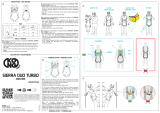 Kong SIERRA DUO TURBO Benutzerhandbuch
Kong SIERRA DUO TURBO Benutzerhandbuch
-
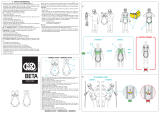 Kong BETA Benutzerhandbuch
Kong BETA Benutzerhandbuch
-
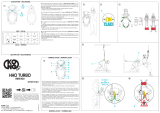 Kong HHO Turbo Benutzerhandbuch
Kong HHO Turbo Benutzerhandbuch
-
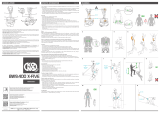 Kong X-FIVE Benutzerhandbuch
Kong X-FIVE Benutzerhandbuch
-
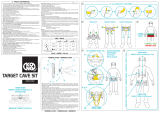 Kong Target Cave Benutzerhandbuch
Kong Target Cave Benutzerhandbuch
-
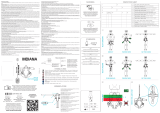 Kong Indiana Benutzerhandbuch
Kong Indiana Benutzerhandbuch
-
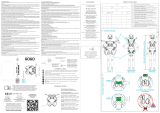 Kong Gogo Benutzerhandbuch
Kong Gogo Benutzerhandbuch
-
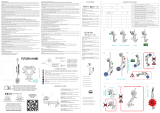 Kong Futura Hand Benutzerhandbuch
Kong Futura Hand Benutzerhandbuch
-
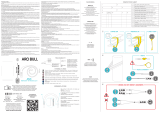 Kong Aro Bull Benutzerhandbuch
Kong Aro Bull Benutzerhandbuch
-
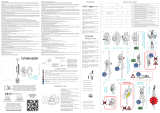 Kong Futura Body Benutzerhandbuch
Kong Futura Body Benutzerhandbuch
Andere Dokumente
-
Petzl C072CA00 Technical Notice
-
Petzl VOLT International Version Technical Notice
-
Petzl VOLT European Version Technical Notice
-
Petzl NEWTON FAST International Version Wichtige Informationen
-
Petzl AVAO BOD international version Technical Notice
-
Petzl NEWTON FAST International Version Wichtige Informationen
-
SKYLOTEC CS2 Instructions For Use Manual
-
Petzl AVAO BOD international version Technical Notice
-
Petzl Croll Technical Notice
-
3M DBI-SALA® Lad-Saf™ X3 Detachable Cable Sleeve 6160054, 9.5MM Bedienungsanleitung













